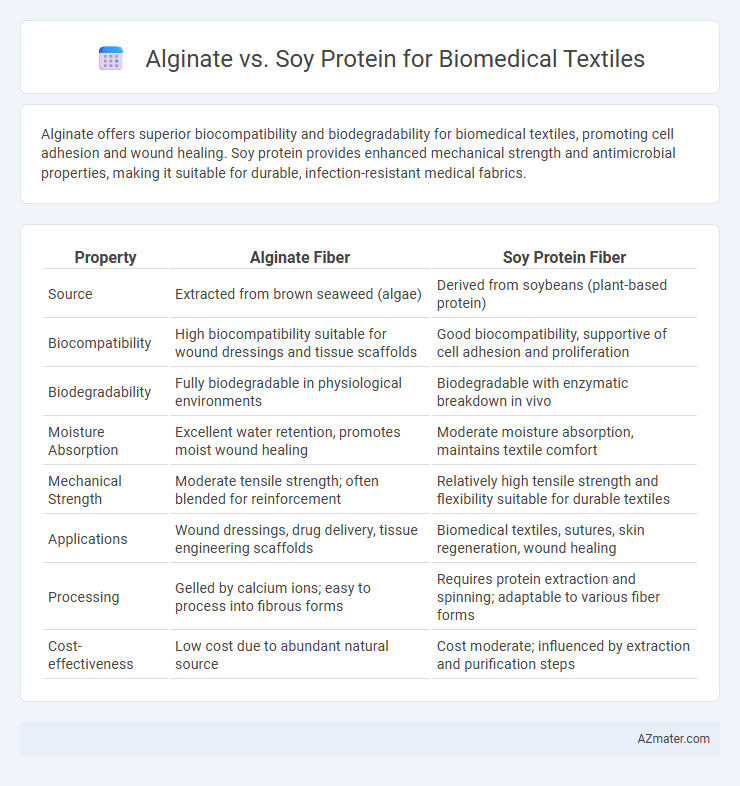Alginate offers superior biocompatibility and biodegradability for biomedical textiles, promoting cell adhesion and wound healing. Soy protein provides enhanced mechanical strength and antimicrobial properties, making it suitable for durable, infection-resistant medical fabrics.
Table of Comparison
| Property | Alginate Fiber | Soy Protein Fiber |
|---|---|---|
| Source | Extracted from brown seaweed (algae) | Derived from soybeans (plant-based protein) |
| Biocompatibility | High biocompatibility suitable for wound dressings and tissue scaffolds | Good biocompatibility, supportive of cell adhesion and proliferation |
| Biodegradability | Fully biodegradable in physiological environments | Biodegradable with enzymatic breakdown in vivo |
| Moisture Absorption | Excellent water retention, promotes moist wound healing | Moderate moisture absorption, maintains textile comfort |
| Mechanical Strength | Moderate tensile strength; often blended for reinforcement | Relatively high tensile strength and flexibility suitable for durable textiles |
| Applications | Wound dressings, drug delivery, tissue engineering scaffolds | Biomedical textiles, sutures, skin regeneration, wound healing |
| Processing | Gelled by calcium ions; easy to process into fibrous forms | Requires protein extraction and spinning; adaptable to various fiber forms |
| Cost-effectiveness | Low cost due to abundant natural source | Cost moderate; influenced by extraction and purification steps |
Introduction to Biomedical Textiles
Alginate and soy protein are prominent biomaterials used in biomedical textiles due to their biocompatibility, biodegradability, and functional properties. Alginate, derived from brown seaweed, offers excellent hydrophilicity and wound healing capabilities, while soy protein provides a renewable, protein-based matrix with good mechanical strength and cell adhesion properties. The integration of these materials in biomedical textiles enhances applications like tissue engineering, wound dressings, and drug delivery systems by combining natural polymer advantages.
Overview of Alginate and Soy Protein
Alginate, a naturally derived polysaccharide from brown seaweed, offers exceptional biocompatibility, biodegradability, and gel-forming capabilities essential for wound dressings and tissue engineering in biomedical textiles. Soy protein, extracted from soybeans, provides a sustainable plant-based option rich in bioactive peptides and functional groups for enhanced cellular interactions and mechanical properties in textile biomaterials. Both alginate and soy protein present unique advantages in developing advanced biomedical textiles, with alginate excelling in moisture retention and soy protein in promoting cell adhesion and proliferation.
Source and Extraction Methods
Alginate, derived from brown seaweed species such as Laminaria and Ascophyllum, is primarily extracted through alkaline extraction followed by precipitation with calcium chloride, ensuring high molecular weight and purity suitable for biomedical textile applications. Soy protein, obtained from defatted soybean meal, undergoes aqueous or enzymatic extraction processes to isolate the protein fraction, often followed by purification steps like ultrafiltration to enhance biocompatibility and mechanical properties. Both biopolymers leverage sustainable natural sources, but alginate's marine origin contrasts with the terrestrial agricultural basis of soy protein, influencing their functional roles in textile biomaterials.
Biocompatibility and Safety Profiles
Alginate exhibits excellent biocompatibility and strong safety profiles, making it widely used in biomedical textiles for wound dressings and tissue engineering due to its non-toxic, biodegradable, and non-immunogenic properties. Soy protein offers good biocompatibility with beneficial cell adhesion characteristics but may present variability in allergenicity depending on extraction purity, which requires careful processing for safe biomedical applications. Both materials provide sustainable options; however, alginate's well-established safety and predictable behavior in biological environments give it an advantage for critical biomedical textile uses.
Mechanical Properties Comparison
Alginate fibers exhibit excellent biocompatibility and moderate tensile strength, making them suitable for biomedical textile applications requiring flexibility and biodegradability. Soy protein fibers demonstrate higher elasticity and improved tensile strength due to their protein structure, but often require crosslinking agents to enhance stability in wet environments. Comparing both, soy protein offers superior mechanical resilience, while alginate provides better hydrophilicity and controlled degradation rates critical for wound healing textiles.
Functionalization and Bioactivity
Alginate offers excellent biocompatibility and gel-forming properties, enabling effective functionalization with bioactive molecules for wound healing applications. Soy protein provides a sustainable and biodegradable matrix with inherent antioxidant activity, which enhances cell proliferation and tissue regeneration in biomedical textiles. Both materials support tailored bioactivity through chemical modification, but alginate's ability to form hydrogels imparts superior moisture retention and controlled release of therapeutic agents.
Degradation and Sustainability
Alginate exhibits rapid biodegradation in biomedical textiles due to its hydrophilic polysaccharide structure, promoting effective tissue integration and minimal environmental impact. Soy protein offers slower degradation rates attributed to its protein-based matrix, enhancing mechanical stability but raising concerns about long-term persistence. Sustainable production favors alginate as it derives from renewable seaweed sources, whereas soy protein depends on agricultural inputs with higher environmental footprints.
Applications in Wound Healing
Alginate and soy protein are both valuable biopolymers used in biomedical textiles for wound healing due to their biocompatibility and functional properties. Alginate excels in absorbing wound exudate and maintaining a moist environment, promoting faster tissue regeneration and reducing infection risk. Soy protein offers antimicrobial properties and enhances cell adhesion, making it effective for developing wound dressings that support healing and reduce inflammation.
Advances in Textile Engineering
Alginate fibers exhibit exceptional biocompatibility and wound healing properties, making them ideal for biomedical textile applications such as tissue scaffolds and wound dressings. Soy protein-based textiles offer enhanced biodegradability and natural antioxidant properties, contributing to improved cell regeneration and reduced inflammation in biomedical uses. Recent advances in textile engineering have optimized electrospinning and blending techniques to enhance mechanical strength and bioactivity of both alginate and soy protein fibers for multifunctional medical textiles.
Future Prospects and Challenges
Alginate exhibits excellent biocompatibility and biodegradability, making it ideal for wound dressings and drug delivery in biomedical textiles, but its mechanical weakness and rapid degradation pose challenges for long-term applications. Soy protein offers promising bioactivity and cost-effectiveness with favorable mechanical properties, yet variability in extraction methods and potential immunogenicity limit its widespread adoption. Future advancements must focus on enhancing the mechanical stability and controlled degradation of alginate, while standardizing soy protein processing and reducing allergenic responses to meet biomedical textile demands.

Infographic: Alginate vs Soy protein for Biomedical textile
 azmater.com
azmater.com